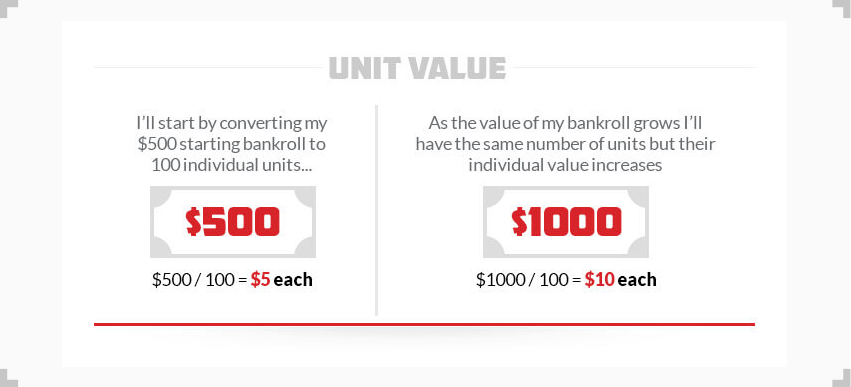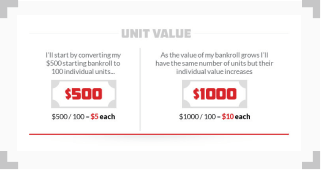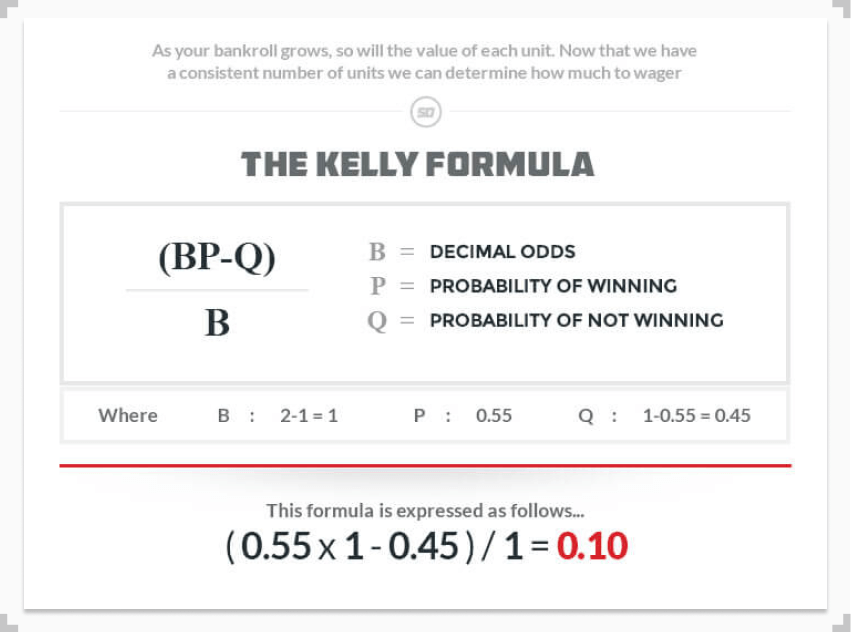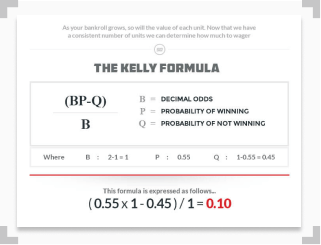How Using the Kelly Criterion Can Boost Your Bankroll

There have been massive changes in the sports betting industry in recent years, with sports bettors accessing more wagering options than ever before (as well as an abundance of tools to find the bets that offer the most value). But while the development of advanced sports analytics and modeling strategies have kept pace with the rapidly-growing market of betting options, many sports bettors still don’t have a solid understanding of many the key strategies sharp bettors use to gain an edge over bookmakers.
This article will introduce you to the Kelly Criterion, a formula that enables you to compare the perceived odds of a wager with the payout odds offered by a sportsbook. The goal? Identifying bets that offer you an edge.
There’s a reason that it’s been used for decades by sharp sports bettors. When applied correctly, the Kelly Criterion not only helps you identify value bets, but also works as an important guide as to how much of your bankroll you should wager on a specific bet.
The Kelly Criterion and the Importance of Bankroll Management
Following bankroll management fundamentals is key to effectively gauging your successes (or failures) at a sportsbook. Without knowledge of what a bankroll is and how important it is to manage it, the Kelly Criterion wouldn’t make any sense.
Bankroll management includes taking a common sense approach to sports betting by dedicating a specific amount of money to wagering and keeping orderly track of your betting history. It also includes making bets based on units, rather than dollar amounts.
For example, let’s say you are starting with a bankroll of $500. Using the unit approach, you would divide your bankroll into 100 units of $5 each.


As your bankroll grows, so will the value of each unit. A shrinking bankroll will be reflected in the diminished value of individual units. But while the size of your bankroll is destined to fluctuate, the strategy of measuring your bankroll in units is critical to determining how much you will wager once you discover a value bet.
However, the challenge of determining how many units to wager on a value bet remains. That is where the Kelly Criterion can play a crucial role in your betting success.
The Kelly Criterion Explained
Developed in the 1950s by Bell Labs scientist John Kelly Jr., the Kelly Criterion has gained a widespread following among sharp bettors.
When used in conjunction with your preferred sports analytics and modeling tools, the Kelly Criterion formula can identify value on the odds board, and provide a guide as to how many units you should wager on a specific bet.
How to Use the Kelly Criterion Formula
Here’s how the Kelly Criterion formula works.
The Kelly Criterion can be expressed as a simple equation as follows:


The example of a coin toss is often used to explain the method in simplified terms.
Let’s say that you have the opportunity to wager on a coin toss with decimal odds of 2.00 (+100 in moneyline odds) using a coin that you have identified as turning up heads 55% of the time.
Accordingly, the values are represented as follows:
P=0.55
Q=1-0.55=0.45
B=2-1=1
You can find these same numbers in the image above, and the Kelly Criterion Formula expresses it as follows:
(0.55×1-0.45)/1=0.10
What this means is that you should wager 10 units (or 10% of your bankroll) on this coin toss.
While it is possible to create a simple spreadsheet that will execute the Kelly Criterion Formula, there is no shortage of online Kelly Criterion calculators will do much of the hard work for you.
Pitfalls to Avoid in Applying the Kelly Criterion
The Kelly Criterion is not without its flaws. Depending on the values applied, the formula has been known to instruct sports bettors to wager excessive numbers of units on wagers. Also, the effectiveness of the formula is limited by the ability of the sports bettor to find value on the odds board.
Most importantly, the sports bettor should understand that using the Kelly Criterion for sports betting will not provide a fast track to a wagering pot of gold. It’s simply designed to be used as a tool to manage risk and represents just one arrow in the quiver of sports betting bankroll management.
Looking to up Your Game? Start Managing Your Bankroll Today!
As most novice sports bettors quickly discover, laying wagers without first identifying value bets (and understanding how to manage your stack) can quickly drain your sportsbook account.
Honing your ability to uncover the best bets at your local sportsbook is a valuable skill. By incorporating sound bankroll management into your game with proven techniques like the Kelly Criterion, you’ll take an important step towards making your sports betting experience both fun and profitable.

Evergreen Writer/Editor; Sportsbook Expert
With nearly two decades of experience in sports media, Paul Costanzo turned his professional attention to sports betting and online gambling in January of 2022. He's covered every angle of the industry since then, managing and creating content for PlayMichigan and The Sporting News, and now SBD.



